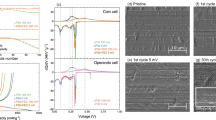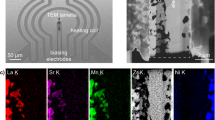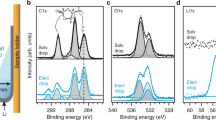Abstract
Photoelectron spectroscopic measurements have the potential to provide detailed mechanistic insight by resolving chemical states, electrochemically active regions and local potentials or potential losses in operating solid oxide electrochemical cells (SOCs), such as fuel cells. However, high-vacuum requirements have limited X-ray photoelectron spectroscopy (XPS) analysis of electrochemical cells to ex situ investigations. Using a combination of ambient-pressure XPS and CeO2−x/YSZ/Pt single-chamber cells, we carry out in situ spectroscopy to probe oxidation states of all exposed surfaces in operational SOCs at 750 °C in 1 mbar reactant gases H2 and H2O. Kinetic energy shifts of core-level photoelectron spectra provide a direct measure of the local surface potentials and a basis for calculating local overpotentials across exposed interfaces. The mixed ionic/electronic conducting CeO2−x electrodes undergo Ce3+/Ce4+ oxidation–reduction changes with applied bias. The simultaneous measurements of local surface Ce oxidation states and electric potentials reveal the active ceria regions during H2 electro-oxidation and H2O electrolysis. The active regions extend ∼150 μm from the current collectors and are not limited by the three-phase-boundary interfaces associated with other SOC materials. The persistence of the Ce3+/Ce4+ shifts in the ∼150 μm active region suggests that the surface reaction kinetics and lateral electron transport on the thin ceria electrodes are co-limiting processes.
This is a preview of subscription content, access via your institution
Access options
Subscribe to this journal
Receive 12 print issues and online access
$259.00 per year
only $21.58 per issue
Buy this article
- Purchase on Springer Link
- Instant access to full article PDF
Prices may be subject to local taxes which are calculated during checkout




Similar content being viewed by others
References
Atkinson, A. et al. Advanced anodes for high-temperature fuel cells. Nature Mater. 3, 17–27 (2004).
Minh, N. Q. Ceramic fuel-cells. J. Am. Ceram. Soc. 76, 563–588 (1993).
Huang, Y. H., Dass, R. I., Xing, Z. L. & Goodenough, J. B. Double perovskites as anode materials for solid-oxide fuel cells. Science 312, 254–257 (2006).
Zhan, Z. L. & Barnett, S. A. An octane-fueled solid oxide fuel cell. Science 308, 844–847 (2005).
Adler, S. B. Factors governing oxygen reduction in solid oxide fuel cell cathodes. Chem. Rev. 104, 4791–4843 (2004).
Haile, S. M. Fuel cell materials and components. Acta Mater. 51, 5981–6000 (2003).
Steele, B. C. H. & Heinzel, A. Materials for fuel-cell technologies. Nature 414, 345–352 (2001).
Brandon, N. P., Skinner, S. & Steele, B. C. H. Recent advances in materials for fuel cells. Annu. Rev. Mater. Res. 33, 183–213 (2003).
Shao, Z. P. & Haile, S. M. A high-performance cathode for the next generation of solid-oxide fuel cells. Nature 431, 170–173 (2004).
Esch, F. et al. Electron localization determines defect formation on ceria substrates. Science 309, 752–755 (2005).
Fleig, J. On the width of the electrochemically active region in mixed conducting solid oxide fuel cell cathodes. J. Power Sources 105, 228–238 (2002).
Mogensen, M., Sammes, N. M. & Tompsett, G. A. Physical, chemical and electrochemical properties of pure and doped ceria. Solid State Ion. 129, 63–94 (2000).
Yang, L. et al. Enhanced sulfur and coking tolerance of a mixed ion conductor for SOFCs: BaZr0.1Ce0.7Y0.2−xYbxO3−δ . Science 326, 126–129 (2009).
Campbell, C. T. & Peden, C. H. F. Chemistry—oxygen vacancies and catalysis on ceria surfaces. Science 309, 713–714 (2005).
Fu, Q., Saltsburg, H. & Flytzani-Stephanopoulos, M. Active nonmetallic Au and Pt species on ceria-based water-gas shift catalysts. Science 301, 935–938 (2003).
Murray, E. P., Tsai, T. & Barnett, S. A. A direct-methane fuel cell with a ceria-based anode. Nature 400, 649–651 (1999).
Ganduglia-Pirovano, M. V., Hofmann, A. & Sauer, J. Oxygen vacancies in transition metal and rare earth oxides: Current state of understanding and remaining challenges. Surf. Sci. Rep. 62, 219–270 (2007).
Trovarelli, A. in Catalysis by Ceria and Related Materials (ed. Trovarelli, A.) Ch. 2 (Imperial College Press, 2002).
Hsieh, G., Mason, T. O., Garboczi, E. J. & Pederson, L. R. Experimental limitations in impedance spectroscopy. 3. Effect of reference electrode geometry/position. Solid State Ion. 96, 153–172 (1997).
Krishnan, V. V., McIntosh, S., Gorte, R. J. & Vohs, J. M. Measurement of electrode overpotentials for direct hydrocarbon conversion fuel cells. Solid State Ion. 166, 191–197 (2004).
Schichlein, H., Muller, A. C., Voigts, M., Krugel, A. & Ivers-Tiffee, E. Deconvolution of electrochemical impedance spectra for the identification of electrode reaction mechanisms in solid oxide fuel cells. J. Appl. Electrochem. 32, 875–882 (2002).
Metzger, P., Friedrich, K. A., Muller-Steinhagen, H. & Schiller, G. SOFC characteristics along the flow path. Solid State Ion. 177, 2045–2051 (2006).
Chan, S. H., Chen, X. J. & Khor, K. A. Reliability and accuracy of measured overpotential in a three-electrode fuel cell system. J. Appl. Electrochem. 31, 1163–1170 (2001).
Winkler, J., Hendriksen, P. V., Bonanos, N. & Mogensen, M. Geometric requirements of solid electrolyte cells with a reference electrode. J. Electrochem. Soc. 145, 1184–1192 (1998).
Pomfret, M. B. et al. Hydrocarbon fuels in solid oxide fuel cells: In situ Raman studies of graphite formation and oxidation. J. Phys. Chem. C 112, 5232–5240 (2008).
Pomfret, M. B., Owrutsky, J. C. & Walker, R. A. In situ studies of fuel oxidation in solid oxide fuel cells. Anal. Chem. 79, 2367–2372 (2007).
Cheng, Z. & Liu, M. L. Characterization of sulfur poisoning of Ni–YSZ anodes for solid oxide fuel cells using in situ Raman micro spectroscopy. Solid State Ion. 178, 925–935 (2007).
Sumi, H. et al. Changes of internal stress in solid-oxide fuel cell during red-ox cycle evaluated by in situ measurement with synchrotron radiation. J. Fuel Cell Sci. Technol. 3, 68–74 (2006).
Liu, D. J. & Almer, J. Phase and strain distributions associated with reactive contaminants inside of a solid oxide fuel cell. Appl. Phys. Lett. 94, 224106 (2009).
Wilson, J. R. et al. Three-dimensional reconstruction of a solid-oxide fuel-cell anode. Nature Mater. 5, 541–544 (2006).
Fister, T. T. et al. In situ characterization of strontium surface segregation in epitaxial La0.7Sr0.3MnO3 thin films as a function of oxygen partial pressure. Appl. Phys. Lett. 93, 151904 (2008).
Ogletree, D. F., Bluhm, H., Hebenstreit, E.D. & Salmeron, M. Photoelectron spectroscopy under ambient pressure and temperature conditions. Nucl. Instrum. Methods Phys. Res. 601, 151–160 (2009).
Salmeron, M. & Schlogl, R. Ambient pressure photoelectron spectroscopy: A new tool for surface science and nanotechnology. Surf. Sci. Rep. 63, 169–199 (2008).
Siegbahn, H. & Lundholm, M. A method of depressing gaseous-phase electron lines in liquid-phase ESCA spectra. J. Electron Spectrosc. Relat. Phenom. 28, 135–138 (1982).
Doron-Mor, H. et al. Controlled surface charging as a depth-profiling probe for mesoscopic layers. Nature 406, 382–385 (2000).
Ertas, G. & Suzer, S. in Surface Chemistry in Biomedical and Environmental Science (eds Blitz, J. P. & Gun’ko, V. M.) Ch. 5 (Springer, 2006).
Ladas, S., Kennou, S., Bebelis, S. & Vayenas, C. G. Origin of non-Faradaic electrochemical modification of catalytic activity. J. Phys. Chem. 97, 8845–8848 (1993).
Bard, A. J. & Faulkner, L. R. Electrochemical Methods, Fundamentals and Applications (John Wiley, 2001).
Vetter, K. J. Electrochemical Kinetics: Theoretical and Experimental Aspects (Academic, 1967).
Mogensen, M. in The CRC Handbook of Solid State Electrochemistry (ed. Trovarelli, A.) Ch. 15 (CRC Press, 1997).
Kwon, O. H. & Choi, G. M. Electrical conductivity of thick film YSZ. Solid State Ion. 177, 3057–3062 (2006).
Grass, M. E. et al. New ambient pressure photoemission endstation at Advanced Light Source beamline 9.3.2. Rev. Sci. Instrum. 81, 053106 (2010).
Mullins, D. R., Overbury, S. H. & Huntley, D. R. Electron spectroscopy of single crystal and polycrystalline cerium oxide surfaces. Surf. Sci. 409, 307–319 (1998).
Fleig, J. On the current–voltage characteristics of charge transfer reactions at mixed conducting electrodes on solid electrolytes. Phys. Chem. Chem. Phys. 7, 2027–2037 (2005).
Acknowledgements
This work was financially supported by the ONR through Contract number N000140510711. We thank the University of Maryland Nanocenter and the University of Maryland Energy Research Center (UMERC) for support. The Advanced Light Source is supported by the Director, Office of Science, Office of Basic Energy Sciences, of the US Department of Energy under Contract No. DE-AC02-05CH11231. Work at Sandia National Laboratories is supported by the Laboratory Directed Research and Development programme under contract DE-AC04-94AL85000 of the United States Department of Energy.
Author information
Authors and Affiliations
Contributions
All co-authors contributed to the conception and design of experiments. The ALS team collected and analysed the XPS data. The Sandia team collected the electrochemical data. The Maryland team fabricated and characterized cells and collated data analysis. Z.H. and M.A.L. initiated and partially financially supported the collaboration.
Corresponding authors
Ethics declarations
Competing interests
The authors declare no competing financial interests.
Supplementary information
Supplementary Information
Supplementary Information (PDF 440 kb)
Rights and permissions
About this article
Cite this article
Zhang, C., Grass, M., McDaniel, A. et al. Measuring fundamental properties in operating solid oxide electrochemical cells by using in situ X-ray photoelectron spectroscopy. Nature Mater 9, 944–949 (2010). https://doi.org/10.1038/nmat2851
Received:
Accepted:
Published:
Issue Date:
DOI: https://doi.org/10.1038/nmat2851
This article is cited by
-
Operando analysis of a solid oxide fuel cell by environmental transmission electron microscopy
Nature Communications (2023)
-
The Mechanism of Selective Dissolution Reaction of Columbite with H2SO4
Mining, Metallurgy & Exploration (2023)
-
The effects of microstructural parameters on the electrochemical properties of LSM-LSCF composite cathode by the particle-based discrete element method
Ionics (2021)
-
In situ quantification of interphasial chemistry in Li-ion battery
Nature Nanotechnology (2019)
-
Selective high-temperature CO2 electrolysis enabled by oxidized carbon intermediates
Nature Energy (2019)



